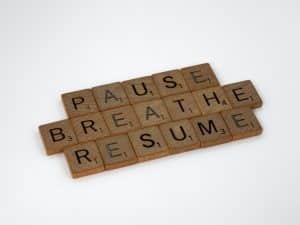
The MBA world is nothing if not solution-oriented. It’s full of past, present and future consultants, and even those of us who don’t fit that mold are all about fixing what’s broken, or at least could be better (and what can’t be better, right??), in most of what we do.
When diagnosing a problem – or let’s say an “opportunity” – for a team or organization, how often does the issue turn out to be something internal? Pretty often, actually. In fact, lots of projects are all about taking a look at internal processes, and producing an honest assessment of the “current state” before making recommendations for the future. The only way to be able to move forward effectively is to be real about what’s going on internally right now.
Hmmm, that sounds like something I’ve heard before….
It’s so much easier when it’s about someone else’s “current state,” isn’t it? When it’s an organization, well that’s cake. Forget that organizations are just groups of people. We look closely, find issues, proclaim them clearly in words, and countless charts and graphs, and start talking about next steps.
Things are a little different when you’re the project, though. I mean, let’s be honest. How do you respond when you realize there’s a critical, internal issue that’s getting in the way of your maximum potential?
I know you want to say that you accept that truth and begin to resolve it, but you know you don’t. You may do lots of things that make it look like that’s what’s happening. You may even believe it yourself. But chances are, you’re falling into the same step one that we all do: denial. You’re either pretending that the issue isn’t really that real, or that you can take care of it just by deciding it’s resolved.
Would you let a client give that noise? Well, you probably would since they’re the client, you’d walk outta there rolling your eyes thinking, “Call me when I can say I told you so.”
Mindfulness is a really effective tool for turning you into your own best consultant. At first, it makes you feel good. You’re calmer, more focused, and generally feel a little more in control. Sometimes, just knowing it’s there makes you feel a little better. Other times, it’s insanely annoying and you dread dealing with it. But you do, because you’ve made a commitment.
Then, when you work with it long enough, other things may start to surface. You notice things – thoughts, emotions, habitual patterns and responses – that are going on inside you that you didn’t know were there, and perhaps would prefer to keep it that way. Well, don’t forget that you’re also the client here, so that’s your prerogative. You can call BS and walk away from the project.
Or, you can choose to double down and see what kind of solutions might lie on the other side of it. There’s only one way to find out, right?
Mindfulness offers a path to self-knowledge through the intentional effort of encountering your own internal landscape. And I will tell you right now in no uncertain terms, it can be a jungle in there. Frankly, if it seems like it isn’t, you probably haven’t been practicing long enough.
At some point in your mindfulness practice, you are going to feel uncomfortable. What you do when that happens is completely up to you. The upside is that there’s no judgement. You’re the client, so you get to do what works best for you today. The other piece of good news, though, is that this is a contract with no expiration date. If discomfort gets a hard pass today, it might not tomorrow. You get to decide, and you’re always right.
Your mindfulness practice will give you recommendations. What kind of “future state” you choose to embrace is entirely up to you.
You know what you’d tell your clients, though. Is it really any different when that client is you?
Photo credit: Matthew Henry



